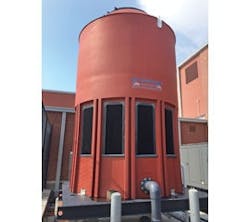Boosting Cooling Tower Price-Performance Ratio
About the author: Greg Rankin is an account manager for Power PR. Rankin can be reached at [email protected] or 310.787.1940.
When Joe Matthews—vice president of construction at Vista Air Services, a contractor that deals with all aspects of HVAC systems—was considering a self-contained, water-cooled HVAC system for a customer near Galveston Bay, Texas, he primarily had system efficiencies on his mind. Because a cooling tower would be essential to the system, however, he also was concerned about the salt air and corrosive emissions from several surrounding chemical plants that would corrode a conventional metal-clad cooling tower shell, making frequent maintenance and replacement necessary over the years.
The application was a 66,000-sq-ft industrial turbine repair station and training facility of Mitsubishi Power Systems, for its power generation turbines. “B.R. Gonzales, a sales rep from AC Engineered Systems, one of our suppliers, suggested that we go with a Delta cooling tower because AC has had success with those in Florida,” Matthews said. “Considering the potential for salt air corrosion, we felt that what was appropriate for Florida would also be suitable for a plant in the proximity of Galveston Bay.”
Matthews also found that the HDPE cooling tower would be more economical to maintain.
“Considering the potential operating savings, I was surprised to learn that the initial purchase price was also substantially lower than many conventional models,” Matthews said.
The water-cooled system that Vista sold to Mitsubishi was a space-saving design that would economize plant space compared with an air-cooled system, which would entail massive package units.
“We installed four 40-ton air handlers mounted to the exterior walls, plus four 20-ton air handlers inside,” Matthews said. “With a typical 40-ton air-cooled package you’ll have a 450-sq-ft footprint. With our water-cooled system, we are taking up less than 30 sq ft.”
Price-Performance Ratio
When evaluating the purchase of most types of capital equipment, the obvious factors to consider are price and performance. But an important factor that should not be overlooked is value added: an amenity or service—such as warranty or engineering assistance—that substantially increases the worth of the product, or potential return on investment.
When it comes to purchasing a cooling tower, an integral component of many HVAC and heat exchanger systems, value added often is significant. This is because factors such as warranty or engineering and installation assistance can be crucial to performance and extend the service life of the equipment. Hence, the price-performance ratio may be enhanced.
This potential is realized by cooling tower technologies, such as a shell composed of HDPE (high-density polyethylene) “engineered plastic.”
Application in Georgetown, Ky.
Engineered HDPE plastic cooling towers recently were installed as part of an HVAC application at two Scott County Schools facilities in the Georgetown, Ky., area.
Adam Berning, sales engineer with Delta representative Blackmore & Glunt, explained that the county school board agreed to install HDPE cooling towers because of the economies offered in purchase price and imperviousness to the harsh chemicals required to treat the hard water used in the system.
“The director of maintenance said Georgetown, Ky., has the ‘worst water on the face of the Earth,’” Berning said. “He said they have to frequently clean their cooling towers, removing a salt-like residue that readily accumulates.”
Berning explained that knowing the HDPE cooling tower will be virtually untouched by any corrosives was a major factor in the school board’s decision. But another important factor was the ability to colorize the cooling tower installed on the roof at one location.
“The board wanted to have one of the cooling towers match the brick exterior of the school where it is installed,” Berning said. “Ordinarily, getting a colorized cooling tower from the factory would be a challenge. The color was to be a custom rust-brown that the architect specified. Custom colors are available from the factory. They simply inject the appropriate-colored resin into the HDPE to make it exactly the color you want. So, when the cooling tower arrived, it matched the building quite well.”
Berning stated that the manufacturer also provided special water drainage outlets and a cooling tower platform.
He added that the cooling system scheme at one of the schools called for the cooling tower to operate in two stages. Value was added here through the inclusion of a variable-speed drive (VFD) compatible fan motor with the cooling tower package.
“The first stage of cooling is provided when water is pumped through the tower without the tower fan running,” Berning said. “As the system fluid temperature rises above a threshold as determined by the building automation system, the cooling tower fan is turned on to provide additional capacity. Once the fan is on, a VFD modulates the fan speed to provide the right amount of cooling. As a standard, the motor provided by Delta Cooling Towers is rated for operation through a VFD, and the VFD it provides easily communicates with the building automation system.”
Plastic’s Performance Benefits
One of the major problems that plagues conventional cooling tower performance is corrosion imposed by the environment (e.g., salt air, industrial pollutants) or cooling system waters and their required chemical water treatment. With a shell of galvanized sheet metal, conventional models can be maintenance-intensive and destined for a relatively brief service life, often seven years or fewer. The maintenance factor is not only expensive in terms of downtime, but it also is laborious to clean or coat away corroded shell panels and weld or gasket patches. Plus, the amount of chemicals required to inhibit corrosion also costly.
Conversely, HDPE engineered plastic cooling towers are impermeable to corrosion. Therefore, they require little maintenance and downtime, and normally require relatively inexpensive chemicals used to retard biological growth.
HDPE models are available in single and modular configurations from 10 to 2,400 cooling tons. They are in wide use for HVAC and heat exchanger applications throughout commercial, industrial and institutional facilities.
Download: Here
